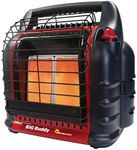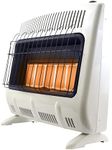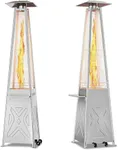Buying Guide for the Best Propane Gas Heaters
Propane gas heaters are a popular choice for providing warmth in various settings, such as homes, garages, workshops, and outdoor spaces. When selecting a propane gas heater, it's important to consider several key specifications to ensure you choose the right model for your needs. Understanding these specifications will help you make an informed decision and ensure that the heater you select is safe, efficient, and effective for your intended use.BTU RatingBTU stands for British Thermal Unit, and it measures the heating capacity of the heater. The higher the BTU rating, the more heat the heater can produce. This spec is important because it determines how effectively the heater can warm up a space. For small rooms or areas, a heater with a lower BTU rating (5,000-10,000 BTUs) may be sufficient. For larger spaces or outdoor areas, you may need a heater with a higher BTU rating (20,000-50,000 BTUs or more). To pick the right BTU rating, consider the size of the area you need to heat and the level of warmth you desire.
Safety FeaturesSafety features are crucial in propane gas heaters to prevent accidents and ensure safe operation. Common safety features include tip-over protection, which automatically shuts off the heater if it is knocked over, and oxygen depletion sensors (ODS), which shut off the heater if oxygen levels in the room drop too low. These features are important for preventing fires and ensuring that the heater does not pose a risk to your health. When choosing a heater, look for models that include these safety features, especially if you plan to use the heater in enclosed or high-traffic areas.
PortabilityPortability refers to how easy it is to move the heater from one location to another. This is important if you need to use the heater in different areas or if you plan to store it when not in use. Portable heaters typically have handles, wheels, or a lightweight design. If you need a heater that can be easily transported, look for models that are compact and have built-in carrying handles or wheels. For stationary use, portability may be less of a concern, and you can opt for a larger, more powerful unit.
Ignition TypeThe ignition type determines how the heater is started. Common ignition types include manual ignition, piezo ignition, and electronic ignition. Manual ignition requires a match or lighter to start the heater, while piezo ignition uses a push-button mechanism to create a spark. Electronic ignition is the most convenient, as it allows you to start the heater with the push of a button. The ignition type is important for ease of use and convenience. If you prefer a hassle-free startup, look for heaters with electronic ignition. For those who don't mind a bit of manual effort, piezo or manual ignition may be suitable.
Fuel ConsumptionFuel consumption indicates how much propane the heater uses over a certain period, usually measured in pounds per hour. This spec is important for understanding the operating cost and how often you will need to refill the propane tank. Lower fuel consumption means the heater is more efficient and will require less frequent refills. To choose the right fuel consumption rate, consider how long you plan to use the heater and how often you are willing to refill the propane tank. For extended use, a heater with lower fuel consumption is more economical.
Heating AreaThe heating area specifies the maximum space the heater can effectively warm, usually measured in square feet. This is important for ensuring that the heater can adequately heat the intended area. Smaller heaters may cover areas up to 200 square feet, while larger models can heat spaces of 1,000 square feet or more. To pick the right heating area, measure the size of the space you need to heat and choose a heater that can cover that area. For larger or open spaces, opt for a heater with a higher heating area rating.























